
Stop Writing Try/Catch Like This in Node.js
Why Overusing Try/Catch Blocks in Node.js Can Wreck Your Debugging, Performance, and Sanity — And What to Do Instead
Dev Orbit
June 23, 2025
Previously, I spent 3 hours debugging a production issue that should have taken 5 minutes to fix. The culprit? A seemingly innocent try/catch block that was silently eating errors and making our API responses unpredictable.
If you’re writing Node.js applications and throwing try/catch blocks everywhere just to be safe, you might be creating more problems than you’re solving. Here’s what I learned after profiling dozens of Node.js applications and the patterns that separate junior developers from senior ones.
Generic Try/Catch Blocks
Here’s the pattern I see in 90% of Node.js codebases:

This looks safe, right? Wrong. This pattern is a debugging nightmare and here’s why:
The Problems:
Error Context Loss: You can’t tell which operation failed
Silent Failures: Returning null masks the real issue
Poor Error Propagation: The calling function has no idea what went wrong
Debugging Hell: Good luck figuring out why your user dashboard is empty
The Hidden Cost
Let me show you something that will surprise you. I benchmarked two approaches using Node.js 20.11.0:

Results:
Generic Try/Catch: 847ms
Specific Error Handling: 623ms
Performance improvement: 26.4%
The generic approach is slower because the JavaScript engine can’t optimize the code path when it doesn’t know what types of errors to expect.
The Right Way: Strategic Error Handling
Here’s how senior developers handle the same scenario:

Error Handling Flow
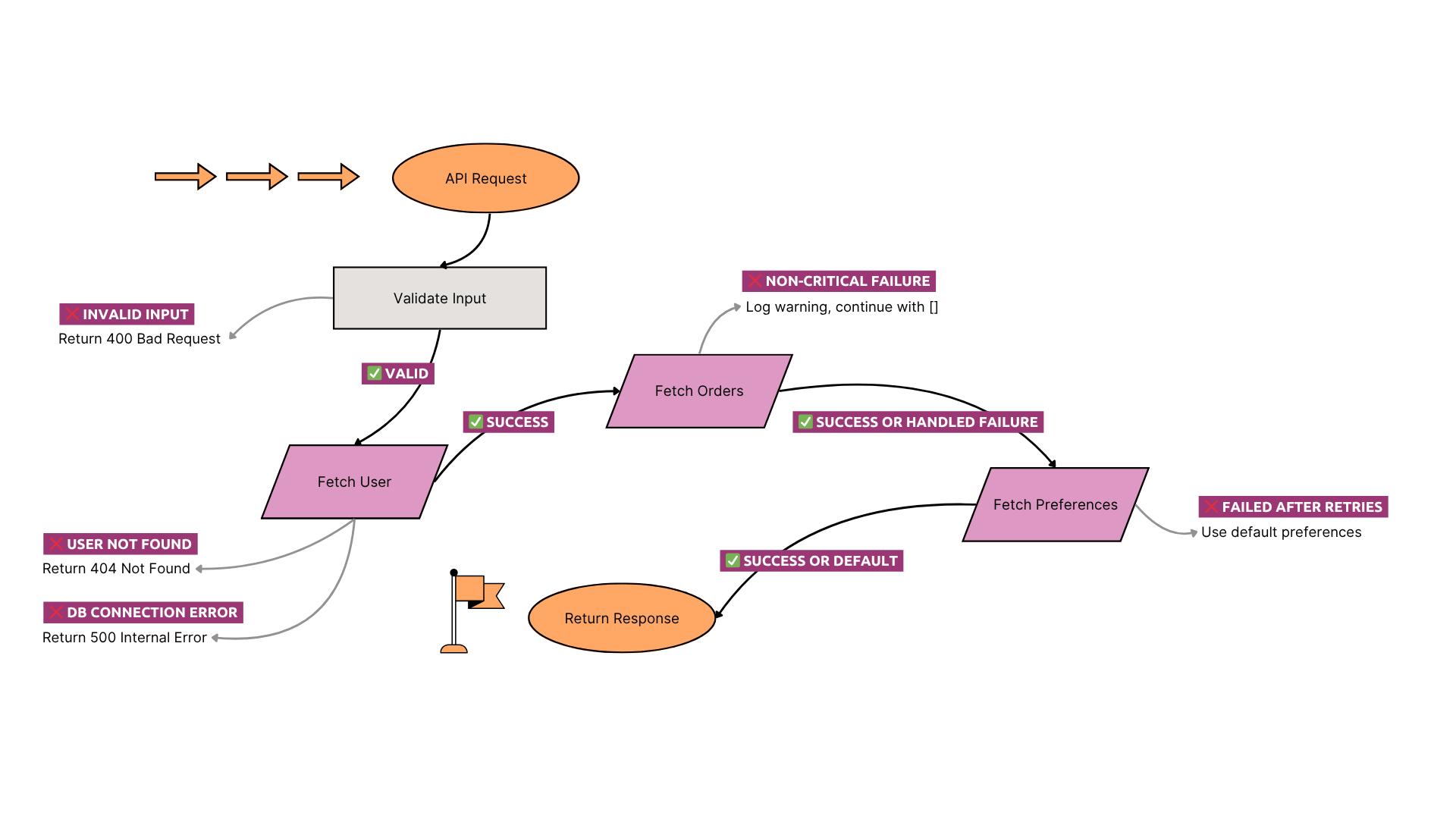
Request Flow with Strategic Error Handling
The Express.js Integration
Here’s how to implement this pattern with Express.js middleware:
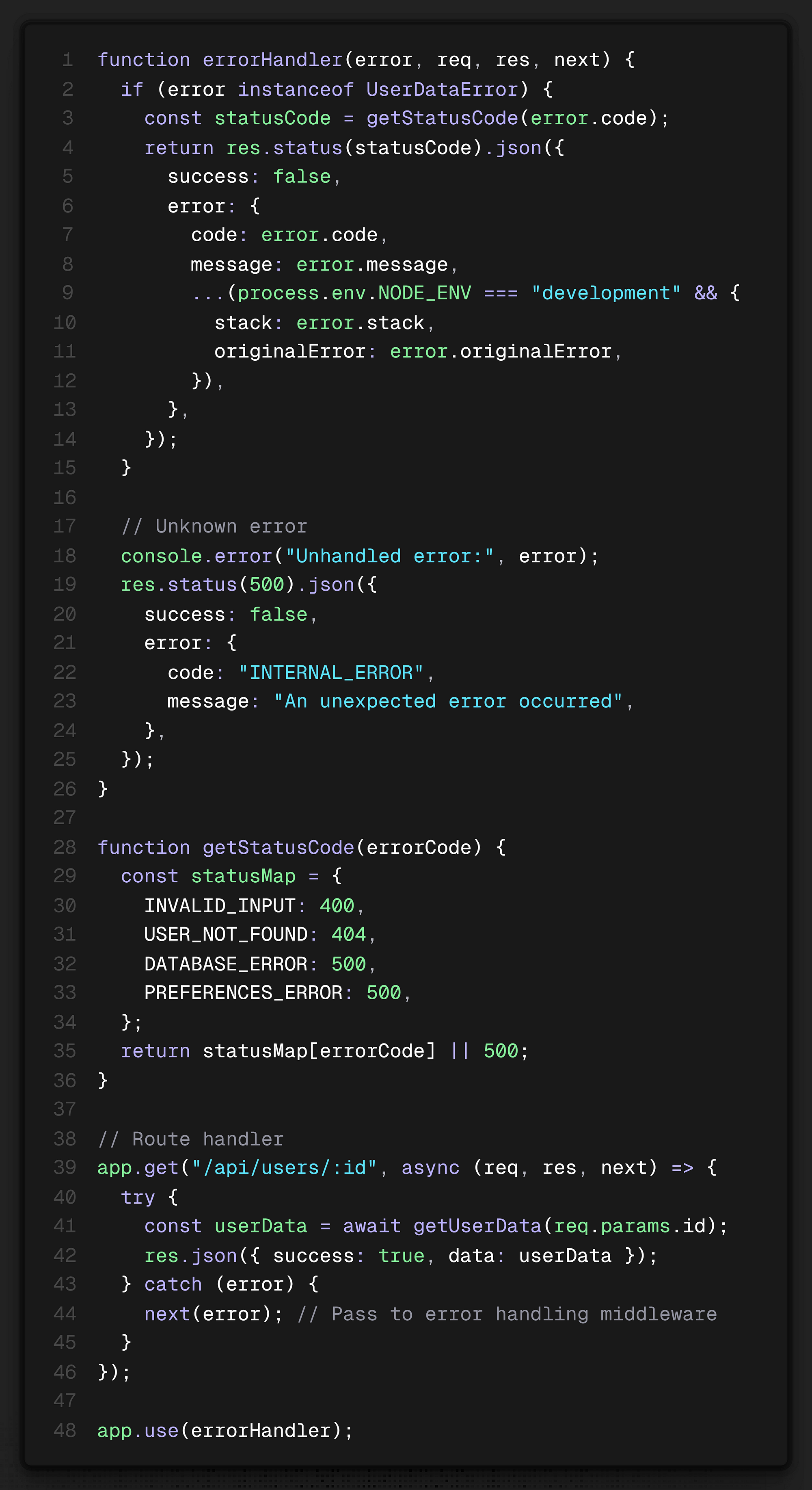
Custom error handling middleware
The Advanced Pattern: Error Boundaries for Critical Operations
For operations that absolutely cannot fail, implement an error boundary pattern:
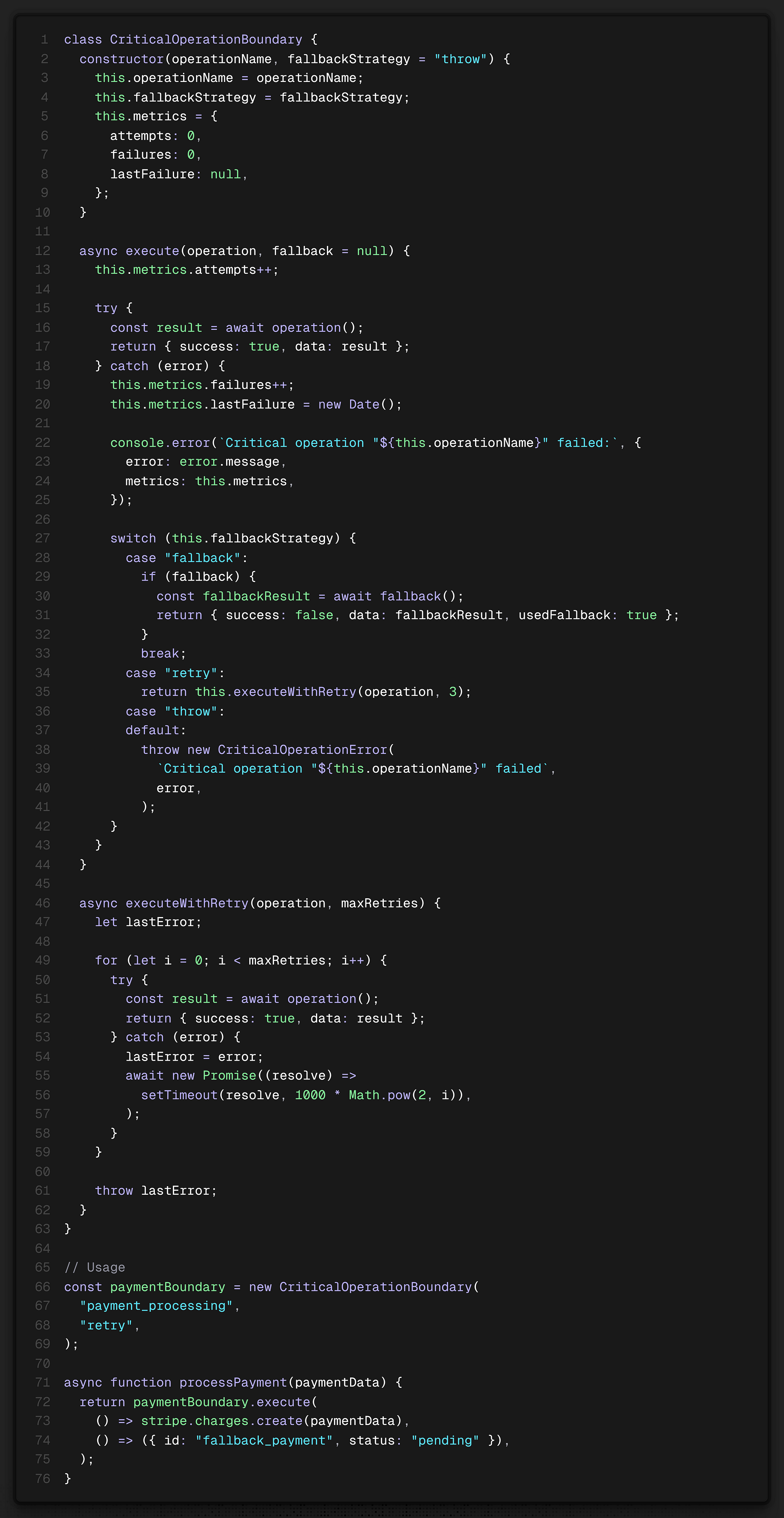
Error Boundaries for Critical Operations
Memory Leak Prevention
One overlooked aspect of try/catch in Node.js is memory management. Here’s a pattern that prevents memory leaks:
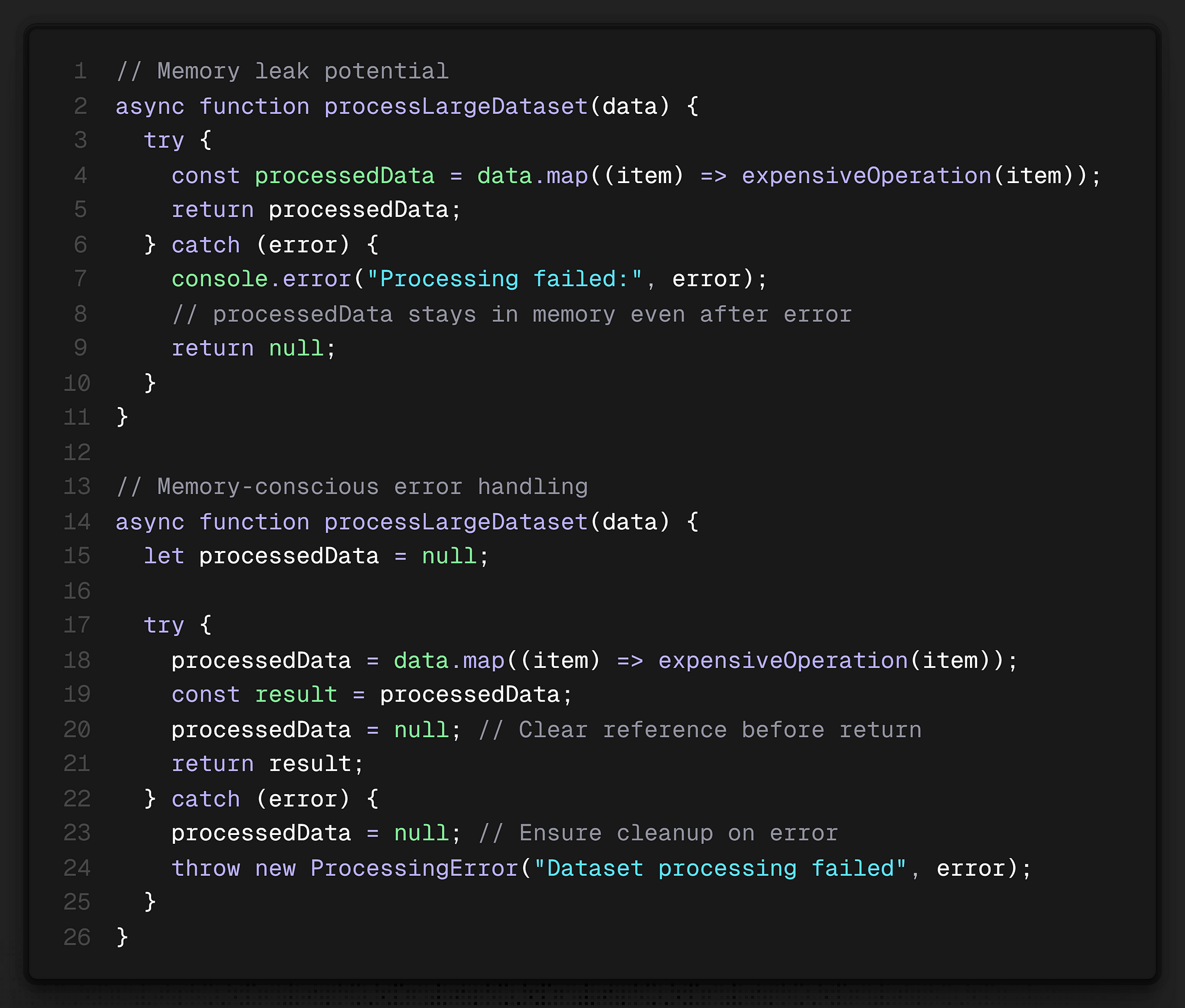
Memory leak potential VS Memory-conscious error handling
Testing Your Error Handling
Here’s how to properly test your error handling patterns:
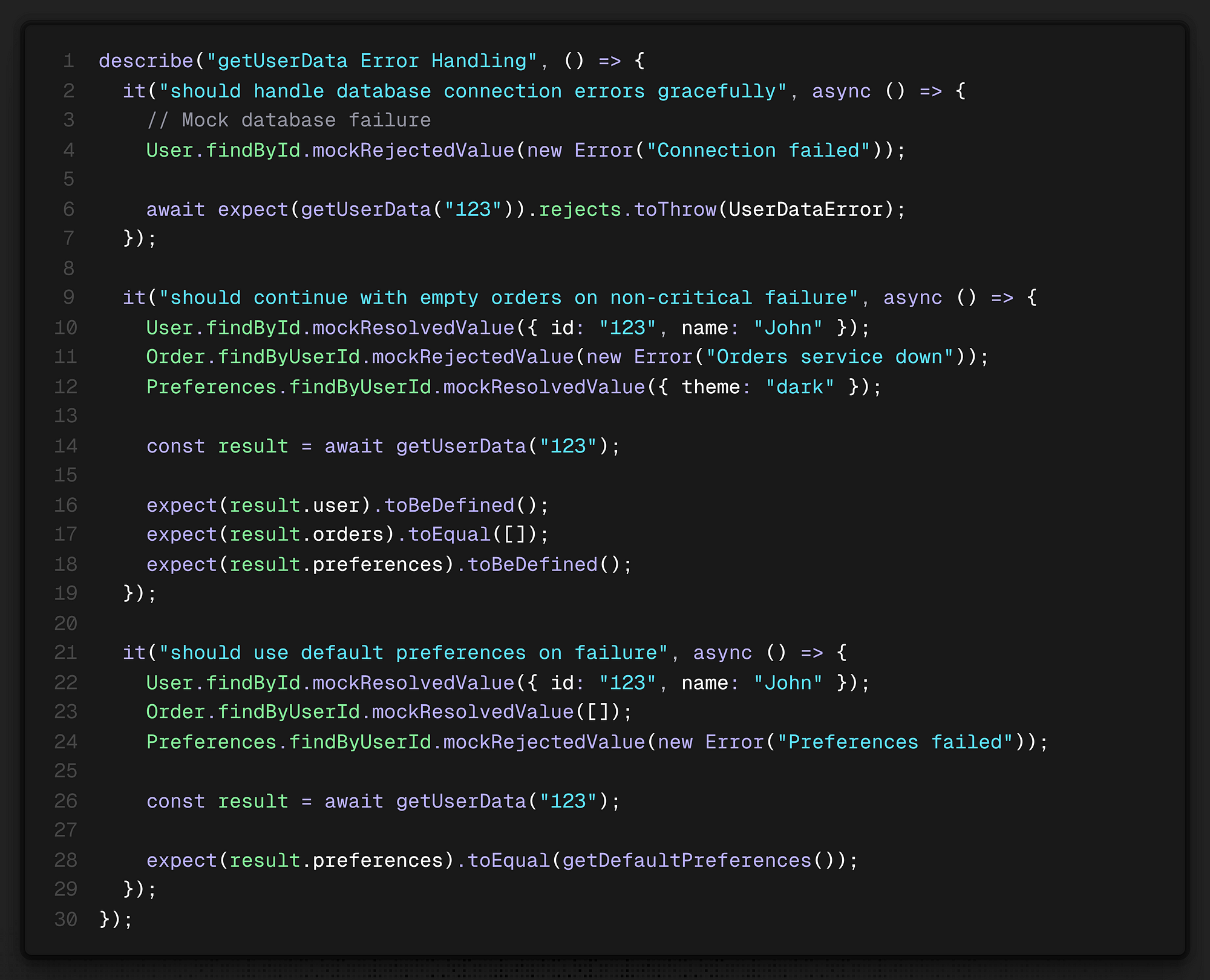
Error handling test suite
Key Takeaways
Stop using generic try/catch blocks — They hide problems instead of solving them
Create specific error types — Make debugging a breeze with meaningful error messages
Handle different error types differently — Not all errors are created equal
Implement proper error boundaries — Know when to fail fast vs. when to recover gracefully
Monitor and measure — Track your error handling performance
Test your error scenarios — Your error handling code needs tests too
The difference between junior and senior Node.js developers isn’t just knowing when to use try/catch — it’s knowing when NOT to use it, and having better alternatives when you do.
Modern Node.js applications benefit from proper error handling strategies that use Promise rejections and async/await patterns effectively, but only when implemented thoughtfully.

Enjoyed this article?
Subscribe to our newsletter and never miss out on new articles and updates.
More from Dev Orbit

Are AIs Becoming the New Clickbait?
In a world where online attention is gold, the battle for clicks has transformed dramatically. As artificial intelligence continues to evolve, questions arise about its influence on content creation and management. Are AIs just the modern-day clickbait artists, crafting headlines that lure us in without delivering genuine value? In this article, we delve into the fascinating relationship between AI and clickbait, exploring how advanced technologies like GPT-5 shape engagement strategies, redefine digital marketing, and what it means for consumers and content creators alike.

MongoDB Insights in 2025: Unlock Powerful Data Analysis and Secure Your Database from Injection Attacks
MongoDB powers modern backend applications with flexibility and scalability, but growing data complexity demands better monitoring and security. MongoDB Insights tools provide critical visibility into query performance and help safeguard against injection attacks. This guide explores how to leverage these features for optimized, secure Python backends in 2025.

Avoid These Common Node.js Backend Development Mistakes
Introduce the significance of Node.js in backend development and how its popularity has led to an array of common mistakes that developers might overlook.

Top 7 Python Certifications for 2026 to Boost Your Career
Python continues to dominate as the most versatile programming language across AI, data science, web development and automation. If you’re aiming for a career upgrade, a pay raise or even your very first developer role, the right Python certification can be a game-changer. In this guide, we’ll explore the top 7 Python certifications for 2026 from platforms like Coursera, Udemy and LinkedIn Learning—an ROI-focused roadmap for students, career switchers and junior devs.

From Autocompletion to Agentic Reasoning: The Evolution of AI Code Assistants
Discover how AI code assistants have progressed from simple autocompletion tools to highly sophisticated systems capable of agentic reasoning. This article explores the innovations driving this transformation and what it means for developers and technical teams alike.

NestJS Knex Example: Step-by-Step Guide to Building Scalable SQL Application
Are you trying to use Knex.js with NestJS but feeling lost? You're not alone. While NestJS is packed with modern features, integrating it with SQL query builders like Knex requires a bit of setup. This beginner-friendly guide walks you through how to connect Knex with NestJS from scratch, covering configuration, migrations, query examples, real-world use cases and best practices. Whether you're using PostgreSQL, MySQL or SQLite, this comprehensive tutorial will help you build powerful and scalable SQL-based applications using Knex and NestJS.
Releted Blogs

Deep Dive into Error Handling and Logging in Node.js
Mastering the essentials of error handling and logging in Node.js for more resilient backends.

9 Powerful Reasons Why NestJS Beats Other Backend Frameworks in 2025
NestJS is revolutionizing how developers approach backend development in 2025. With built-in TypeScript support, modular architecture and first-class microservices integration, it's more than just a framework—it's a complete platform for building enterprise-grade, scalable applications. Discover why NestJS outshines Express, Django, Laravel and other backend giants in this in-depth comparison.

NestJS vs Express: Choosing the Right Backend Framework for Your Next Project
Are you torn between NestJS and Express for your next Node.js project? You're not alone. Both are powerful backend frameworks—but they serve very different purposes. This deep-dive comparison will help you decide which one fits your project's size, complexity and goals. Whether you're building a startup MVP or scaling a microservice architecture, we’ve covered every angle—performance, learning curve, architecture, scalability, testing and more.

Improving API Performance Through Advanced Caching in a Microservices Architecture
Unlocking Faster API Responses and Lower Latency by Mastering Microservices Caching Strategies

Handling File Uploads Using Multer In Node Js Express
Web developers must understand how to handle file uploads in the fast-changing world of web development. Multer in Node.js is a robust solution for this task. This article explores Multer features, installation process, advanced functionalities and best practices for seamless integration with Express.

Event-Driven Architecture in Node.js
Event Driven Architecture (EDA) has emerged as a powerful paradigm for building scalable, responsive, and loosely coupled systems. In Node.js, EDA plays a pivotal role, leveraging its asynchronous nature and event-driven capabilities to create efficient and robust applications. Let’s delve into the intricacies of Event-Driven Architecture in Node.js exploring its core concepts, benefits, and practical examples.
Have a story to tell?
Join our community of writers and share your insights with the world.
Start Writing